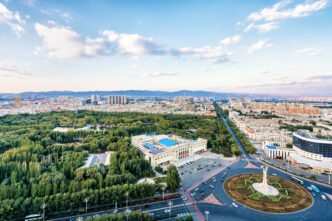Executive Summary
The Story So Far
Why This Matters
Who Thinks What?
China’s factory activity contracted for the seventh consecutive month in October, driven by a decline in new export orders as the temporary boost from front-loaded shipments ahead of President Donald Trump’s tariff threats dissipated. The official Purchasing Managers’ Index (PMI) dropped to 49.0, remaining below the 50-mark that separates growth from contraction, signaling persistent economic headwinds.
Manufacturing Sector Struggles
The National Bureau of Statistics reported on Friday, October 31, 2025, that the official manufacturing PMI fell to 49.0 in October, a six-month low. This figure was down from 49.8 in September and missed a Reuters poll forecast of 49.6, underscoring ongoing challenges for China’s industrial base.
Policymakers had previously relied on producers rushing goods to the United States to pre-empt potential triple-digit levies on Chinese goods. However, analysts had cautioned that this strategy was unsustainable, effectively borrowing future growth to stabilize the world’s second-largest economy in the short term.
Despite efforts by factory owners to diversify by reaching new customers in Europe, Latin America, the Middle East, and Africa, many are reportedly selling at a loss. These alternative markets have not been able to absorb the volume of goods once purchased by the U.S., which previously accounted for approximately $400 billion in Chinese exports.
Impact of Trade Tensions
The prolonged trade tensions have cast a significant shadow over China’s export-driven economy. Economists estimate that the loss of the U.S. market has curtailed export growth by around 2 percentage points, translating to roughly 0.3% of China’s Gross Domestic Product.
Xu Tianchen, a senior economist at the Economist Intelligence Unit, expressed surprise at the drop in the PMI reading, noting that exports appeared to be a major drag. He suggested this might be indicative of a “payback” for the earlier front-loading of export orders.
Non-Manufacturing Sector Shows Modest Growth
In contrast to the manufacturing sector, China’s non-manufacturing purchasing managers’ index (PMI) saw a slight uptick, rising to 50.1 in October from 50.0 in September. This marginal increase was primarily supported by an improvement in the services sector, which edged up to 50.2 from 50.1.
However, the construction component of the non-manufacturing PMI slipped to 49.1 from 49.3 in September, indicating some softness in that area. A separate Reuters poll forecast the private-sector RatingDog PMI to come in at 50.9, a decrease from 51.2 the previous month.
Policy Response and Outlook
While President Trump and Chinese President Xi Jinping recently agreed to de-escalate tensions, including a one-year delay in reciprocal tariffs, analysts believe this agreement offers only a modest boost to exports and does not address the deeper divides between the two superpowers. Zichun Huang, a China economist at Capital Economics, noted that wider headwinds to growth are likely to persist.
This situation places continued pressure on China’s policymakers to devise strategies for a sustainable economic recovery, address a slide in property prices, and strengthen global trade ties. The country’s economic growth slowed to 4.8% in the third quarter, its weakest pace in a year, though it remains on track to meet the official 2025 growth target of around 5%.
Following a recent key policy meeting, the ruling Communist Party pledged to boost domestic consumption and fortify its vast industrial system. Nevertheless, analysts question whether Beijing’s approach will introduce new solutions or merely revert to established practices of channeling resources to large state-owned firms, potentially bypassing private producers and households.
There is a divided opinion among analysts regarding the necessity of further stimulus this year. Some believe current measures are sufficient to meet the annual growth target, while others advocate for more infrastructure investment. Longer-term concerns persist about Beijing’s capacity to rebalance an economy where household consumption significantly lags global averages.








